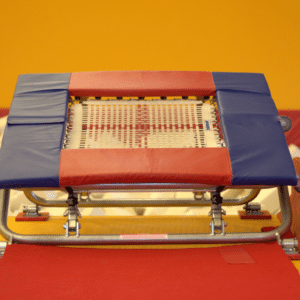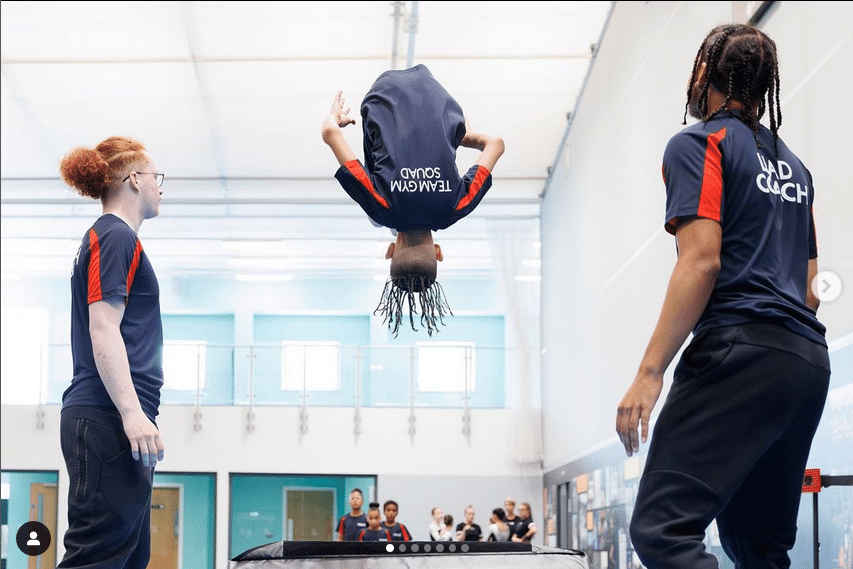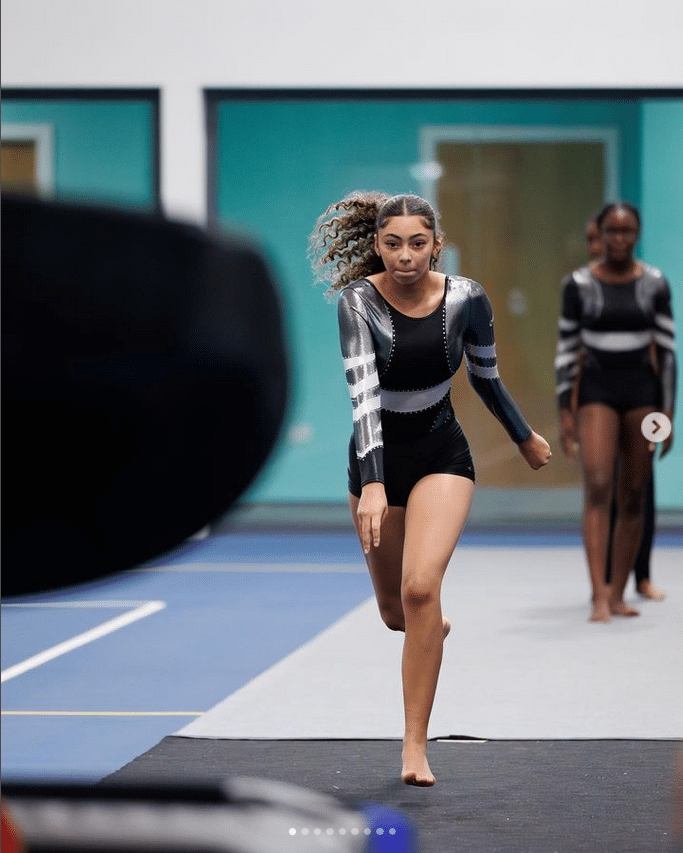
If you’re interested in gymnastics, you may have heard of TeamGym. It’s a gymnastics discipline that combines elements of artistic gymnastics, tumbling, and trampoline to create a team-based competition.
Originally developed in Scandinavian countries, there are both male, female and mixed teams all with the aim of becoming a European champion which is the ultimate prize in TeamGym.
It’s a discipline that we offer here at Synergy Gymnastics with teams regularly winning medals at the British Championships. In this guide, we’ll take a closer look at TeamGym gymnastics and provide a comprehensive guide for beginners.
Group Gymnastics
TeamGym is a form of group gymnastics that emphasizes team-based competition. It’s an exciting and fast-paced sport that combines the disciplines of artistic gymnastics, tumbling, and trampoline. Team Gymnastics is an excellent choice for anyone looking to develop their gymnastics skills in a dynamic team environment.
It’s mainly practiced in European countries, especially Scandinavia, where the discipline originated in the late 80s and early 90s.
Many gymnasts in these countries will train TeamGym from when they first start gymnastics right through to the end of their career. However, TeamGym is also a popular route for older Artistic gymnasts looking for something less intense.
What is Team Gym Gymnastics?
TeamGym is a competitive gymnastics discipline that is based on a team competition in three events:
- Floor
- Tumbling
- Trampette
TeamGym Floor involves the gymnasts performing a routine together that includes elements from artistic gymnastics. The routines are choreographed to music and can last up to two and a half minutes.
Teams also compete tumbling passes with teammates performing in close succession. This is known as streaming and is not found in any other gymnastics discipline.

The third event is Trampette. For those unfamiliar with Trampette, they are essentially mini trampolines but gymnasts run towards them and have only one bounce to take off. In Team Gym, the Trampette event is also streamed with one of the three runs needing to use a vault. Because the Trampette is higher than the usual springboard, the Vault is raised higher than in artistic gymnastics.
History of Team Gym Gymnastics
TeamGym originated in Sweden in the 1990s. It was created as a way to make gymnastics more accessible and to increase participation in gymnastics. The first Championships were held in 1996 in Finland, and the sport has continued to grow in popularity ever since. Originally the sport was called EuroTeam, but the name changed to TeamGym in 2002.
Although the sport has grown in Europe, it is rarely known outside of the continent. As a result, the discipline is not governed by the FIG (the world governing body of gymnastics) as an official gymnastics discipline.
Instead, it is governed by the UEG (European Union of Gymnastics). The UEG organizes the top TeamGym competition – The European Championships.
Some TeamGym gymnasts begin their career as artistic gymnasts but cross over to TeamGym if they cannot meet the intense demands of four-piece or six-piece competitions.
The Benefits of TeamGym Gymnastics
TeamGym offers a wide range of benefits for participants. Talented gymnasts can reach the pinnacle of Team Gym on a much lower number of training hours than in Artistic. Gymnasts here at Synergy that compete in Team Gym typically train around 6-8 hours per week, much less than the 30 to 40 hours per week needed to excel at Artistic gymnastics.
This is a huge benefit for gymnasts that want to train seriously but cannot commit to the intensity of Artistic.
The three events also offer some variation to the training. Some gymnasts are happy to become Tumblers and only focus on that, but some will get bored and like the appeal of training on vault and floor routines as well.
TeamGym also encourages teamwork, communication, and trust. Additionally, it can help to build self-confidence and self-esteem.
Equipment Used in TeamGym Gymnastics
TeamGym requires several different pieces of equipment. The most important pieces are the floor, the tumble track, vault and the trampette.
The floor area is 14 meters by 12 meters and is non-sprung. This is larger than an artistic floor which is only 12 meters by 12 meters and is also sprung.
The tumble track is very similar to the one used in Power Tumbling but is only 14 meters long instead of the 25 meters used in Power Tumbling.
Trampettes are super springy compared to springboards usually used in Vault. The most recognized brands of trampette in Team Gym are Continental, Gymnova, EuroTramp and Dorado. These are completely different to the mini rebounders you might find in a fitness class or someones backyard!
TeamGym Skills
TeamGym requires a wide range of skills. These include skills from artistic gymnastics, such as handstands, cartwheels, and backflips, as well as tumbling skills, such as round-offs, back handsprings, and layouts. Trampoline skills, such as front somersaults, back somersaults, and twists, are also important. On the Vault, Handsprings and Tsukahara type vaults are used, but not Yurchenkos as you cannot back handspring safely onto the trampette in the same way as you can with a springboard.

At the elite level of TeamGym, you will commonly see triple somersaults on both trampette and tumbling track.
TeamGym Competitions
TeamGym competitions involve teams of gymnasts competing against each other. The competitions are divided into three events – women’s, men’s, and mixed. Each team performs a routine that includes elements from all three gymnastics disciplines – floor, tumbling, and trampette.
Tumbling requires three different passes as does Trampette.
Teams are also entered into a specific competition based on age:
| Competition | Age |
| Primary | 9 to 11 years |
| Youth | 10 to 14 years |
| Junior | 13 to 17 years |
| Senior | 16 years plus |
There are some cross overs in age category. For example, a 10 year old could compete in either the Primary or Youth competition. This helps coaches plan their teams accordingly especially if you are at a club with a smaller pool of gymnasts.
Anyone who has ever been to a TeamGym competition will know that the atmosphere can be very loud and energetic compared to most other types of competitions. This really helps the teams on Trampette and Tumbling as they need huge boosts of fast, powerful jumps and flips.
TeamGym Rules and Scoring
The rules of TeamGym competitions are set by the European Union of Gymnastics (UEG). The routines are judged based on the difficulty and execution of the elements, as well as the overall choreography and synchronization of the team.
Individuals can receive deductions for errors or mistakes during the routine and together this will form the team score. The types of errors the judges are looking for are very similar to any other type of gymnastics:
- Form
- Falls on landing
- Technique
In addition they will also be assessing how well the teams stream on Trampette and Tumbling. Streaming is unique to TeamGym because the gymnasts perform their pass closely one after the other with only a few seconds between each person. This brings huge energy to the competitions but can also mean if a gymnast makes a mistake on landing their team mate will be arriving on the landing mat very soon behind them.

Teams are scored on a scale of 0 to 20, based on the difficulty and execution of the routine. The scores from all three disciplines are added together to give a final team score. The team with the highest score wins.
Successful TeamGym Teams
TeamGym has produced several successful teams over the years. On a national level the Scandinavian countries have dominated although new countries have started to challenge the status quo in recent years including Great Britain and Italy.
The most successful Senior National Teams:
- Denmark (Men – 12 European Golds / Mixed – 8 European Golds)
- Sweden (Women – 7 European Golds)
- Iceland (Women – 3 European Golds)
- Norway (Women and Mixed – 1 European Gold each)
In the UK the most successful TeamGym Clubs include:
- Bracknell
- Portsmouth SOG
- Scarborough
- Newcastle
- Leatherhead
- Heathrow
- Majestic
- Saltire
Conclusion
TeamGym Gymnastics is an exciting and challenging discipline that combines elements of artistic gymnastics, tumbling, and trampoline. It’s a great choice for anyone looking to develop their gymnastics skills in a team environment or anyone that is looking for a serious but less intense option to Artistic gymnastics.
FAQs
What is the difference between TeamGym and Artistic Gymnastics?
While both sports involve gymnastics, Team Gymnastics is a team-based competition that combines elements from three different gymnastics disciplines – artistic gymnastics, tumbling, and trampoline. Artistic Gymnastics, on the other hand, is an individual competition that involves four apparatuses – floor exercise, vault, uneven bars, and balance beam or six apparatuses for men – floor, vault, high bar, pommel horse, parallel bars and rings.
How many gymnasts are on a TeamGym team?
A Team Gymnastics team can have between 6 and 12 gymnasts, depending on the competition.
Is TeamGym safe?
Like all gymnastics disciplines, safety is of utmost importance in TeamGym. Trampette can be especially risky due to the great height generated and the multiple somersaults performed at the Junior and Senior levels. Coaches put safety precautions in place such as small progressions, additional safety matting and spotting the gymnasts in case they make a mistake. The risk of injury in gymnastics can never be completely eliminated so consider this carefully before starting training.
Can anyone try out TeamGym Gymnastics?
TeamGym is a competitive discipline so most clubs and coaches will invite more able gymnasts to try out TeamGym in their club. Here at Synergy most of our TeamGym gymnasts started out in a recreational level class before moving up.
Sources
